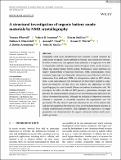A structural investigation of organic battery anode materials by NMR crystallography
Abstract
Conjugated alkali metal dicarboxylates have recently received attention for applications as organic anode materials in lithium and sodium-ion batteries. In order to understand and optimise these materials, it is important to be able to characterise both the long-range and local aspects of the crystal structure, which may change during battery cycling. Furthermore, some materials can display polymorphism or hydration behaviour. NMR crystallography, which combines long-range crystallographic information from diffraction with local information from solid-state NMR via interpretation aided by DFT calculations, is one such approach, but this has not yet been widely applied to conjugated dicarboxylates. In this work, we evaluate the application of NMR crystallography for a set of model lithium and sodium dicarboxylate salts. We investigate the effect of different DFT geometry optimisation strategies and find that the calculated NMR parameters are not systematically affected by the choice of optimisation method, although the inclusion of dispersion correction schemes is important to accurately reproduce the experimental unit cell parameters. We also observe hydration behaviour for two of the sodium salts, and provide insight into the structure of an as-yet uncharacterised structure of sodium naphthalenedicarboxylate. This highlights the importance of sample preparation and characterisation for organic sodium-ion battery anode materials in particular.
Citation
Whewell , T , Seymour , V R , Griffiths , K , Halcovitch , N R , Desai , A V , Morris , R E , Armstrong , A R & Griffin , J M 2022 , ' A structural investigation of organic battery anode materials by NMR crystallography ' , Magnetic Resonance in Chemistry , vol. Early View . https://doi.org/10.1002/mrc.5249
Publication
Magnetic Resonance in Chemistry
Status
Peer reviewed
ISSN
0749-1581Type
Journal article
Description
V.R.S., A.V.D., A.R.A. R.E.M. and J.M.G.are indebted to the Faraday Institution NEXGENNA project (FIRG018) for financial support. We acknowledge the support of the Leverhulme Doctoral Scholarships Programme in “Material Social Futures” (grant number DS-2017-036) for the provision of a PhD studentship to T.W. We acknowledge the support from CCP-NC, funded by the EPSRC (EP/M022501/1), and the UKCP consortium, funded by the EPSRC (EP/P025561/1). K.G. acknowledges the Leverhulme Trust (Research Project Grant Number RPG-2018-395). We are grateful to the UK Materials and Molecular Modelling Hub for computational resources, which is partially funded by the EPSRC (EP/P020194). The UK High-Field Solid-State NMR Facility used in this research was funded by EPSRC and BBSRC (EP/T015063/1) as well as, for the1 GHz instrument, EP/R029946/1.Collections
Items in the St Andrews Research Repository are protected by copyright, with all rights reserved, unless otherwise indicated.

